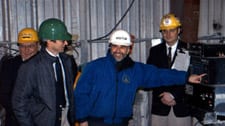Construction Begins on WHOI’s New Coastal Vessel
April 30, 2003
With the press of a computer button and the plasma cutting of a sheet of aluminum, construction began earlier this month on the Woods Hole Oceanographic Institution’s (WHOI) new 60-foot coastal vessel at Gladding-Hearn Shipbuilding, Duclos Corporation in Somerset, MA. The $1.6 million vessel is scheduled for delivery in March 2004.
Changing research needs and an increasing scientific focus on near-shore waters require that the Institution replace its current coastal vessel, the 46-foot Asterias, which has been in operation since 1980. The new vessel, designed by Roger Long Marine Architecture, Inc. of Cape Elizabeth, Maine, with considerable input from WHOI scientists and ship operations staff, will offer researchers expanded capabilities, including a cruising speed of 20 knots, double that of Asterias, providing quick access to local waters, especially to the Institution’s Martha’s Vineyard Coastal Observatory off Edgartown. The faster cruising speed of the vessel will allow scientists and engineers to work farther offshore than before, within narrow weather windows, and spend more time on station and less in transit. The new vessel will have an operational range of 350 miles from Woods Hole, providing investigators with practical access to an area from the Hudson River and New York Harbor to the Gulf of Maine.
“Asterias has been a good vessel, but it is clear changing research needs and societal questions our scientists seek to address require a much more capable vessel,” said WHOI Vice President for Marine Operations Richard Pittenger. “This new vessel will provide researchers with a new generation of near-shore vessel with tremendous capabilities for many years to come.”
The new vessel, to be owned and operated by WHOI, will support scuba, surface supplied and snorkel divers by including a more accessible dive platform, a dive locker and shower, wet suit racks and warm water on deck. Its stern A-frame will be able to handle complex instrument arrays and coastal moorings, and the fantail area and booms will allow scientists and engineers to tow new instrument arrays. State-of-the-art instrumentation aboard the vessel will allow scientists to make advanced meteorological and oceanographic measurements.
“Scientists and engineers are pursuing more complex problems and using increasingly sophisticated equipment they often design, build, and need to test,” said Ernest “Dutch” Wegman, WHOI’s Port Engineer and project manager for the new boat. “Their needs at sea have changed significantly in the past decade, and it became clear we needed a new coastal vessel to accommodate their research interests.”
The vessel can accommodate six people for overnight trips or up to 10 people for day trips. At less than $2,000 a day, its competitive day rate makes it a cost effective platform for instrument testing, coastal studies and educational programs. Opportunities for students to conduct research, previously limited by the realities of 30-40 day cruises on the Institution’s larger research vessels, will now be within a day’s reach with the new vessel.
The new vessel is being built at Gladding-Hearn Shipbuilding, a family operated business in Somerset, MA, that has built more than 330 boats since 1955. The shipyard is known for building fast ferries, police and fire boats, pilot and tug boats, and small research vessels. It recently delivered a 55-foot vessel, the Fay Slover, of similar design to WHOI’s new vessel to Old Dominion University in Virginia, and has a number of boats under construction, including a 145-foot ferry for Wall Street commuters.
WHOI is a private, independent marine research and engineering, and higher education organization located in Falmouth, MA. Its primary mission is to understand the oceans and their interaction with the Earth as a whole, and to communicate a basic understanding of the ocean’s role in the changing global environment. Established in 1930 on a recommendation from the National Academy of Sciences, the Institution is organized into five scientific departments, interdisciplinary research institutes and a marine policy center, and conducts a joint graduate education program with the Massachusetts Institute of Technology.


